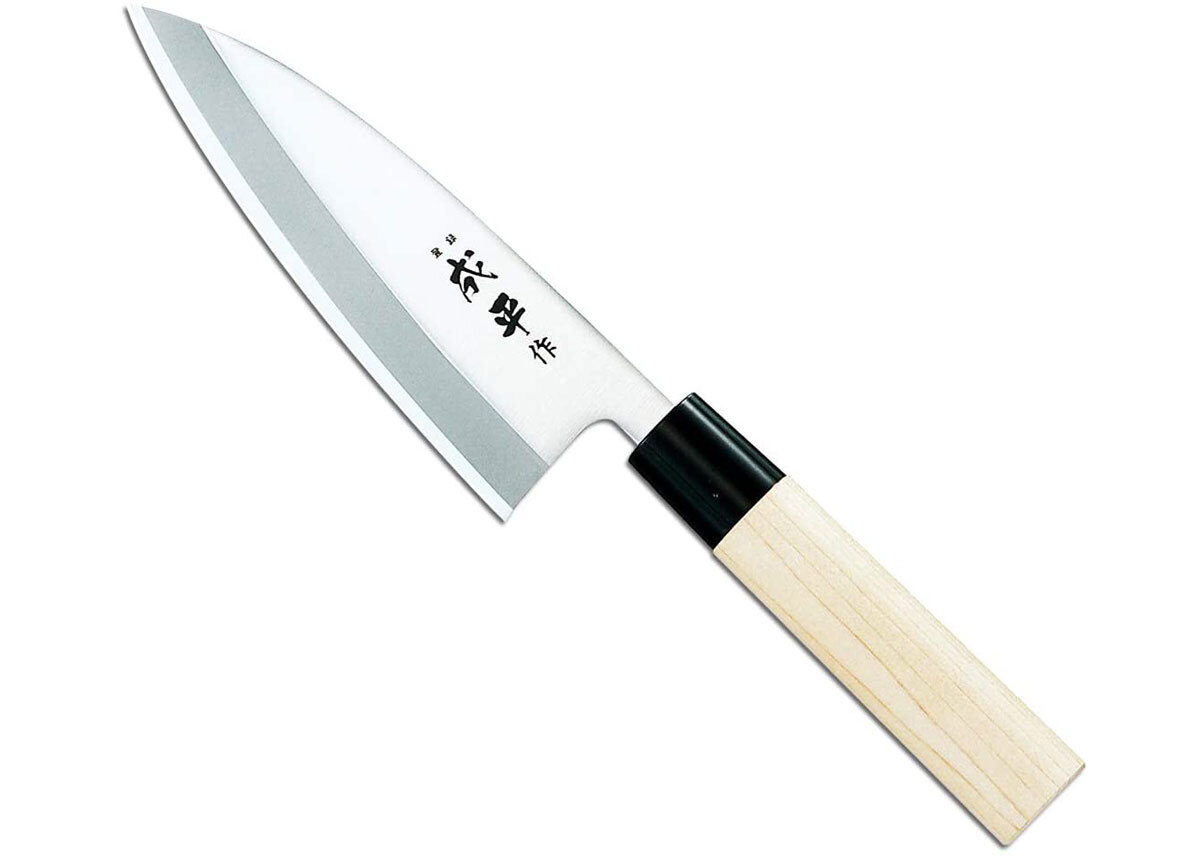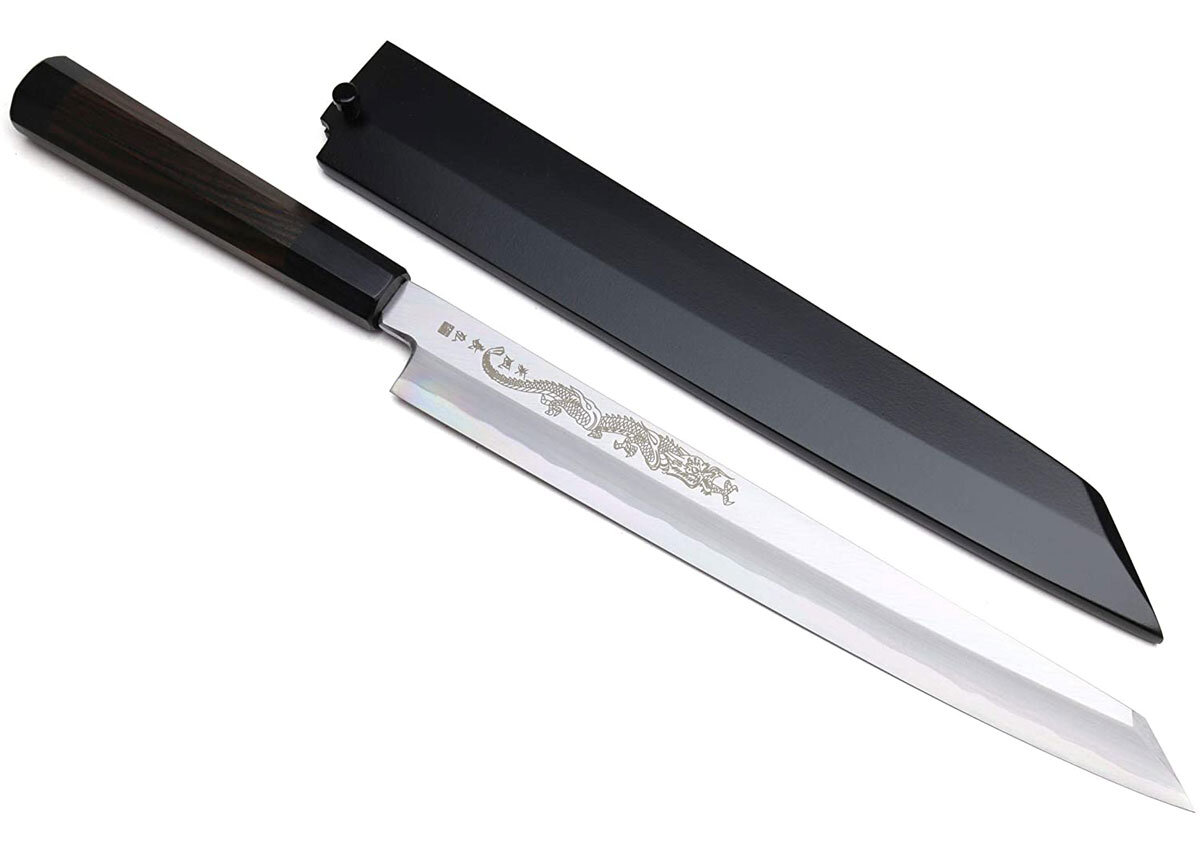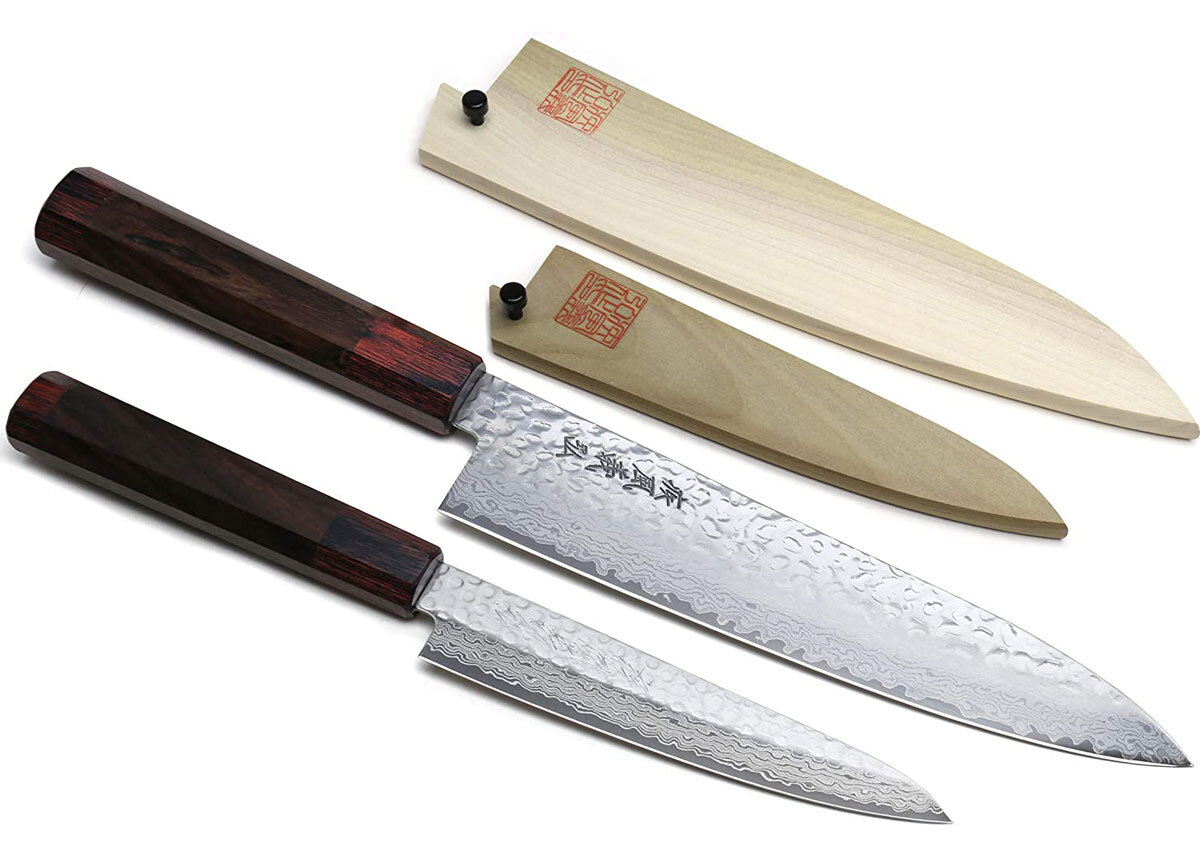How to Select the Best Japanese Knives: All You Need to Know
by Teni Wada & Samantha Cubbison | CRAFT
© Tottori Prefectural Government, Otsuka Yoshifumi Knives
Attention all chefs, aspiring and professional! If you’re serious about food preparation and
presentation, then you certainly know the value of a proper knife. Though knives are easily the most essential culinary tool, perhaps none are more highly valued than Japanese knives!
Our guide covers everything you need to know about Japanese knives, starting with their history, the forging process, and the different types of Japanese knives. As a bonus, we’ve even included a list of the 10 best Japanese knives that you can purchase on Amazon!
Whether you’re here to find the right Japanese knife for your kitchen or simply wish to satisfy an underlying curiosity about artisanal craftsmanship of the Japanese blade, read on!
1. Why Choose a Japanese Knife?
2. The History of Japanese Knives
3. How are Japanese Knives Made?
4. Where are Japanese Knives Made?
5. Types of Japanese Knives
6. How to Take Care of Your Japanese Knife?
7. Where to Buy Chef Knives in Japan?
8. How to Take Your Japanese Knives Home?
9. Where to Buy Japanese Knives Online?
1. Why Choose a Japanese Knife?
© Tottori Prefectural Government, Otsuka Yoshifumi All-Purpose Knife
If you are eager to refine your culinary skills with the right knives tools, there’s no doubt you've done your research, which probably means you’ve narrowed it down to two choices: Should I buy Japanese or German knives? Let’s take a look at your options.
Both German and Japanese knives are considered "the best" in their own ways. Home cooks and professional chefs will swear allegiance by German brands like Wusthof, Henckels or Messermeister, or pledge loyalty to Japanese brands like Yoshihiro Cutlery, Shun, or Kyocera
Each country’s knives have their own set of very unique characteristics, but let’s just look at a few definition features, namely the steel used and the curve of the blade.
German knives are made from stainless steel, making them resistant to corrosion and rust. They are hardier due to the gentle curve of the blade that facilitates the rocking action necessary to mice and chop ingredients common in Western cuisine. Whilst the stainless steel blade is strong, it will dull faster than a Japanese knife, which is made from high-carbon steel.
Japanese knives, on the other hand, are capable of quick precision cuts that can smoothly separate bone and cartilage or slice produce with little resistance. This is all due to the harder, yet lighter Japanese blade, which enables the knife to stay sharper for a longer period of time. In fact, traditional Japanese knives are honed only on one side in order to create the sharpest edge possible.
How did Japanese knives become such highly-coveted instruments of precision? The answer lies in the battlefields of Japanese history.
2. The History of Japanese Knives
Wakizashi in its Scabbard, 16th Century, the Met Museum
Japanese kitchen knives have their roots on the battlefield. Because of this, you’ll find a level of precision that has evolved into an artform in and of itself. Samurai, the ruling military class of premodern Japan, often wore a pair of blades: a katana (a long and curved, single-edged blade) and a wakizashi, a backup weapon, or to better the odds during close combat.
For nearly 700 years, samurai remained Japan’s noble warriors under the shogunate military dictatorship, though they were most active in the 15th and 16th centuries during the Age of Warring States, or sengoku jidai.
© National Museums of World Culture / Creative Commons, Dagger with 500 Year Old Blade
However, the 1868 Meiji Restoration ushered in a wave of industrialization and modernization that no longer needed samurai. As a result, both the creation of katana and its possession were outlawed.
Swordsmiths who had mastered generations of their trade quickly learned to put their skills to another use. They began to forge knives for domestic use, as kitchen knives could be sold for high prices and without limitations. The impeccable pedigree and skills of their creators is why Japanese knives are still highly prized today.
3. How Are Japanese Knives Made?
Japanese knives are made with a technique that sandwiches steel and iron. After heating and softening the metals, steel is inserted into iron then fused with iron sand to both protect and reinforce the sturdiness of the blade. The fused metal is then welded, shaped, and hammered before quenching, a water bath that rapidly cools the steel and increases its strength. Finally, the blade undergoes a few cosmetic transformations to make it a pliable and sharp culinary instrument.
Because samurai and their battle swords developed in a time when Japan consisted of different provinces, various styles of craftsmanship have evolved in different parts of Japan. These techniques have transferred over to the production of knives.
4. Where are Japanese Knives Made?
Sakai City in Osaka Prefecture is one of the top three blade producing areas in Japan, the city is synonymous with rigorously hammered blades and produces 90% of Japan’s handcrafted knives. However, Echizen City, in Fukui Prefecture, forges knives in a unique process known as nimai-hiroge, where two blades are hammered at the same time during the shaping process to create a thicker blade.
© Ryusen Japan, Echizen Uchihamono
Tosa blades, created in Kochi Prefecture, take a completely different approach to knife making called jiyu-tanzo, or free-forging. This involves the molding of cherry-red metal into basically any shape or form, allowing for creative freedom. This method makes mass-production difficult, however, each knife will have its own unique structure, according to the product’s intended general purpose or function.
It should be noted that not all Japanese knives are made from steel. Ceramic knives are just as efficient kitchen tools, and in many ways offer more precision. The lightweight blade is made from zirconium oxide and is sharpened on a diamond dust grinding wheel, resulting in edge retention that is ten times longer than a steel knife. However, ceramic knives are fragile and should be used to compliment, rather than replace, metal chef’s knives. Developed and manufactured in Japan, Kyocera, the world’s leading ceramic knife brand, is headquartered in Kyoto Prefecture, where its pottery and ceramic industry can be traced back to the 5th century. Kyocera, in fact, is a portmanteau of Kyoto and Ceramics.
5. Types of Japanese Knives
© MTC Kitchen, (from top) Honesuki Knife, Nakiri Knife, Deba Knife, Yanagi Knife
Aside from the forging process, what makes Japanese knives useful kitchen tools is that each knife often has a very specific purpose.
Fish is a staple of Japanese cuisine, and the deba knife is designed to behead and fillet fish, while a yanagiba knife has a length and sharpness that allows for smooth cuts of raw fish.
For meat and poultry, the thick blade of a honesuki gets the job done as its pointed tip allows for the smooth separation of bone and cartilage. For home cooks, the double-bevel of the nakiri makes for crisp veggie slices without any fuss.
Despite having the word for cow in the name (gyu), the gyuto knife is the most versatile and useful knife for your kitchen, whether you’re preparing beef, fish, or vegetables. For beginners or connoisseurs alike, the gyuto makes the ideal starter knife. Known as a classic Japanese kitchen knife, it is the combination of several Western and Japanese style blades, and be used to slice vegetables, fish and meat. Its blade is particularly long, and the lightweight construction allows for agile push chopping.
One reputable brand you might consider is Yoshihiro Cutlery, who have been producing Japanese kitchen knives from their base in Sakai for over 100 years. Each knife is individually handcrafted by skilled artisans. You can buy this gyuto knife from Yoshihiro online on Amazon. Check out how these knives are forged in the video below!
© Anton Kudris / Creative Commons, Wooden Handled Japanese Knife
Now that you are more informed on the different types of knives, you may be asking, “But what about the handle?” Well, Japanese Magnolia wood is the go-to for many blade forgers due to the fact that it won’t become slippery when wet. These wooden dowels are carved into oval, octagon or D-shapes to strengthen the wielder’s grip. Handles made of this material are often made in the Wa, ‘Japanese’, construction; meaning it is rather simplistic and lightweight in design.
If you are a lefty, there’s no need to throw in the chef’s hat just yet! Considering the handle and bevel of a knife will make your life (and slices) much better, a Yo or Western handle, works great, regardless of dominant hand. This is due to the stable and crisp nature of the handle. Aside from handles, left-handed chefs should utilize a single-beveled blade that has a left-facing grind. Otherwise, working against the cutting edge may prove difficult.
While you’re thinking about Japanese cuisine, you can check out Everything You Need to Know About Bento Boxes!
6. How to Take Care of Your Japanese Knife?
Kiso Hinoki Cutting Board, Available at Amazon
It’s important to treat your Japanese knives well. Though its high-carbon blade is incredibly tough, Japanese knives are prone to rust, unlike stainless steel. Thoroughly clean and dry your knife after contact with high acidic ingredients like citrus fruitsor tomatoes, otherwise the blade will darken or even turn black. Likewise, routine sharpening will prevent chipping and keep the metal in prime condition.
Aside from periodic sharpening, the quality of your cutting board should not be overlooked. Opt for a cutting board made from the fragrant Japanese cypress, a mold-resistant softwood that will prolong the sharpness of your Japanese knives.
7. Where to Buy Chef Knives in Japan?
Knives can be an unique souvenir for yourself or others to document your trip to Japan. At nearly any knife specialty shop, you’ll be able to request custom engraving. Here are a few shopping options in Japan’s old and new capitals of Kyoto and Tokyo.
When it comes to shopping for knives in Tokyo, the first place to look is Kitchen Town, or Kappabashi. Three stores you mustn't miss are Kamata, Kama Asa, and Tsubaya, though the streets of Kappabashi are lined with a fantastic variety of shops that stock kitchen hardware and culinary tools.
If you’re in Kyoto, there’s no doubt you’ll be visiting a few historical attractions. After you explore Nijo Castle, head to Shigeharu Cutlery. For shops located in downtown Kyoto, there’s Aritsugu, located on the north side of Nishiki market, and Kikuichimonji, east of Teramachi Dori Street,
8. How to Take Your Japanese Knives Home?
It is extremely important to note that Japan has very strict laws on the possession of knives. How strict? Possession of anything with a blade longer than 5.5 cm will find you in violation of local laws. Likewise, permits are needed if one wishes to own any blade over 15 cm.
Make sure your purchases are wrapped and sealed, and palace them in your checked luggage along with your original receipt for good measure.
9. Where to Buy Japanese Knives Online?
For those of you unable to make it to Japan, here's a list of 10 Japanese knives you can find online:
1. Deba Left-handed Knife
A solidly functional entry-level deba knife for left handed chefs who wish to work with whole fish or birds. Deba are primarily used to cut, de-bone, and filet fish, but the knife is also suitable for cutting poultry. However, cutting thick bones should be avoided.
Deba Left-handed Knife – Available at Amazon
2. Usuba Knife
The usuba knife is characterized by its straight blade edge and squared off tips for cleaning and cutting produce. This usuba from Yoshihiro Cutlery comes with a wooden sheath for storage.
Usuba Knife – Available at Amazon
3. Mukimono Knife
Japanese for peeling instrument, the mukimono is a specialized knife designed to intricately cut and carve fruits and vegetables in a decorative manner. This peeling knife is from Takayuki, one of Japan’s leading manufacturers of kitchen knives in Sakai City.
Mukimono Knife – Available at Amazon
4. Gyuto Knife
The gyuto is a combination of several Western and Japanese style blades, and is useful for slicing vegetables, fish, and meat, making it a quality kitchen knife. Made in Sakai City, this gyuto is finely crafted with 32 layers of Damascus Steel and has a sturdy laminated mahogany handle.
Gyuto Knife – Available at Amazon
5. Santoku Knife
With an impressive 46 layers of Damascus steel, this Santoku knife from Yoshihiro Cutlery makes a fine addition to any home kitchen. Lightweight, and sharp out of the box, the santoku is ideal for mincing, cutting, and slicing.
Santoku Knife – Available at Amazon
6. Yanagiba Knife
This yanagiba kiritsuke knife from Yoshihiro Cutlery is a precision tool coveted by sushi chefs. Its octagonal handle fits snugly in the hand as the lightweight blade engraved with a dragon seamlessly thin slices of fish for sushi and sashimi.
Yanagiba Knife – Available at Amazon
7. Nakiri Knife
A 37 layer Damascus steel nakiri knife from Seki City, this handcrafted kitchen tool has a flat blade and no pointed tip. This design makes the nakiri suitable for chopping all types of vegetables without having to use a horizontal push or pull.
Nakiri Knife – Available at Amazon
8. Kyocera 4-Piece Ceramic Knife Set
Ceramic knives are excellent entry-level kitchen tools. Lightweight and very sharp, the ceramic knife easily cuts through butter, cheese, produce and boneless meats. This 4 piece set is from Kyocera, the world's leading manufacturer of ceramic knives.
Ceramic Knife Set – Available at Amazon
9. Gyotoku & Utility Knife Set
If you are eager to add high-quality Japanese knives to your kitchen, try this gyotoku and utility knife set from Yoshihiro Cutlery. Use the gyuto knife for swift rocking and chopping movements and let the utility knife tackle tasks that require more dexterity. Both knives are forged with 46 layers of Damascus steel and come with a wooden sheath.
Gyotoku & Utility Knife Set – Available at Amazon
10. 7-Piece Knife Set with Block
An ideal housewarming gift or purchase for yourself, this 7 piece knife set from Enso consists of a knife block, kitchen shears and 5 knives, all made in Sekai City. The stainless steel knives have a double bevel edge for both right and left-handed users.
Knife Set with Block – Available at Amazon
March 12, 2021 | Craft, Lifestyle, Shopping
JO SELECTS offers helpful suggestions, and genuine recommendations for high-quality, authentic Japanese art & design. We know how difficult it is to search for Japanese artisans and designers on the vast internet, so we came up with this lifestyle guide to highlight great Japanese artworks and designs for your everyday needs.
All product suggestions are independently selected and individually reviewed. We try our best to update information, but all prices and availability are subject to change. Japan Objects is a member of the Amazon affiliates program and if you buy something through our links, Japan Objects may earn an affiliate commission at no additional cost to you.
























ART | February 5, 2022